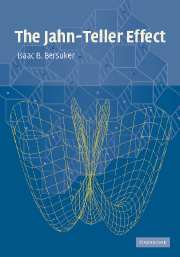Book contents
- Frontmatter
- Contents
- Preface
- Abbreviations
- 1 Introduction
- 2 Vibronic interactions
- 3 Formulation of Jahn–Teller problems. Adiabatic potentials
- 4 Pseudo Jahn–Teller, product Jahn–Teller, and Renner–Teller effects
- 5 Solutions of vibronic equations. Energy spectra and JT dynamics
- 6 The JTE in spectroscopy: general theory
- 7 Geometry, spectra, and reactivity of molecular systems
- 8 Solid-state problems: local properties and cooperative phenomena
- Appendix
- Subject index
- Formula index
4 - Pseudo Jahn–Teller, product Jahn–Teller, and Renner–Teller effects
Published online by Cambridge University Press: 07 December 2009
- Frontmatter
- Contents
- Preface
- Abbreviations
- 1 Introduction
- 2 Vibronic interactions
- 3 Formulation of Jahn–Teller problems. Adiabatic potentials
- 4 Pseudo Jahn–Teller, product Jahn–Teller, and Renner–Teller effects
- 5 Solutions of vibronic equations. Energy spectra and JT dynamics
- 6 The JTE in spectroscopy: general theory
- 7 Geometry, spectra, and reactivity of molecular systems
- 8 Solid-state problems: local properties and cooperative phenomena
- Appendix
- Subject index
- Formula index
Summary
This chapter is to introduce the reader to JT problems that may be considered as “less traditional” in the sense that they do not follow exactly from the original (“classical”) JT theorem. Indeed, the PJTE considered below takes place in nondegenerate states, while the RTE is relevant to linear molecules, which are exceptions in the original JT formulation. The product JTE is an approximation to both JT and PJT problems. All these effects are inalienable components of the JT trend as a whole.
Two-level and multilevel pseudo JT (PJT) problems. Uniqueness of the PJT origin of configuration instability and its bonding nature
Among the JT vibronic coupling effects the pseudo JT (PJT) effect occupies an outstanding place. Indeed, while the occurrence of the JT and RT effects is limited to polyatomic systems in degenerate electronic states, the PJT effect may take place, in principle, in any system without a priori limitations. This circumstance enlarges essentially the possible subjects of the JT vibronic coupling effects, transforming the JTE theory into a general tool for better understanding and solving problems of structure and properties of molecules and crystals. The waiver of the degeneracy restrictions together with the proof of the uniqueness of the PJT origin of structural instabilities of polyatomic high-symmetry configurations elevates the JT effect theory to a general approach to molecular and crystal problems.
The PJT effect emerges directly from the basic equations (2.6) for the vibronically coupled electronic states.
- Type
- Chapter
- Information
- The Jahn-Teller Effect , pp. 110 - 161Publisher: Cambridge University PressPrint publication year: 2006
- 5
- Cited by



